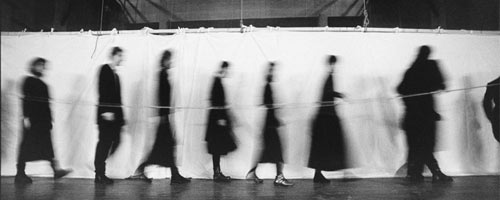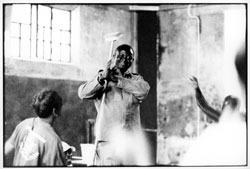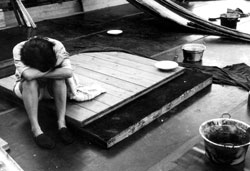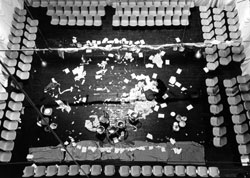   |
|
|
| |
|
|
|
|
 |
Riccardo
Vannuccini |
|
SOCIAL THEATRE:
PRISON EXAMPLE |
|
|
Since the end of the 50s in
the area of theatre, various experiences at a European and
international level begin, that characterise and point out
how theatrical practice, rather than the show, is an
interesting phenomenon.
It is at this stage that, adopting differing expressive
forms such as: happening, performance, stage, workshop,
theatre departs from that exacting theatrical space and
enters into others: mental asylums, prisons, hospitals,
streets, piazzas, the city in general.
|
|
 |
Photo> FRANCESCO GALLI |
My professional experience in the field of art and stage began in 1978 at the Festival nazionale dell’avanguardia in Formello (Rome), and following various differing experiences, I have worked with many Penal Institutions since 1994.
In particular, I have presented workshops, seminars, put on stage shows, photograph exhibitions, art exhibitions beginning with the Roman prison of Rebibbia Femminile, then working in other penetential institutions, among which is Regina Coeli, Civitavecchia N.C. and finally at Rebibbia Reclusione, trying to put the world of prison and theatrical culture into a close and profound social relationship, one meant to “improve” the other and vice versa.
The shows were presented both within and outside the various Institutions and the inmates were also often diretly involved in a supervisory capacity, as well as being in charge of maintenance in the case of art exhibitions or theatrical and musical stage productions, and/or in charge of planning photographic exhibitions and educational communication.
 |
|
 |
Photo> FRANCESCO GALLI |
For an educational and social theatre: notes on
the “Port Royal” 2 project
Theatre as place
of tracks, a chart of particular people and
places who are in need of a relationship
regeneration. But the concept can – and must –
be extended to the reality of the city in all
its aspects, where the territory has been
deprived of a precise urban as well as human
identity.
On the one hand the tradition of the predominant
western renaissance theatre, otherwise called
vision theatre, which privileges a
representation intended as autonomous object
that is far from the vocation of profound
relationship among participants and which
favours that relentless dichotomy of stage and
audience, of time and space, of whoever acts and
whoever watches, and which through repetition,
reducing experience to mere consumable goods,
takes you hostage and dissolves fully mature
relationships.
On the other, theatre intended as group
experience which does not need to show itself,
rather, the conclusive show, should it alter the
experience characteristic of the preparatory
work, is absolutely unadvisable.
In social theatre expression, education and
interaction mechanisms come to life. In the
first case, theatre action gives suitable voice
and tools to who generally, owing to a situation
of deprivation, is not able to express himself
in a condition of communicativeness. Secondly,
it becomes a way for the maturing of individual
and collective identities. Thirdly, it arouses
new actions which unfold in reciprocity and in
the sharing of the experience.
The tools are the performing activities and the
stage must not be the end onto itself, as in
bourgeois and judicial theatre, rather, a
pathway. Education needs a territory where
education takes place and does not need an idea
to which education is directed. |



Photo> FRANCESCO GALLI |
|
|